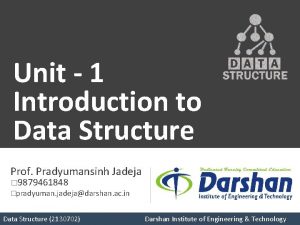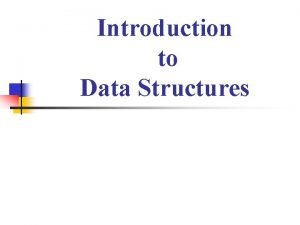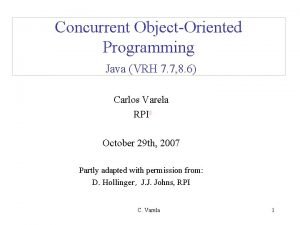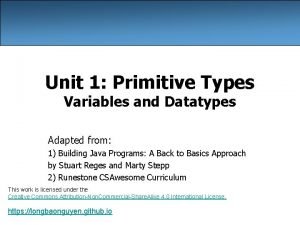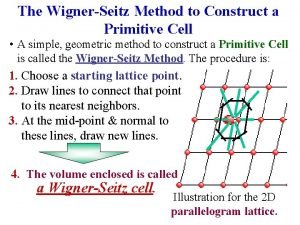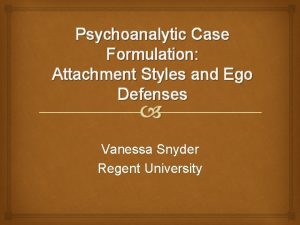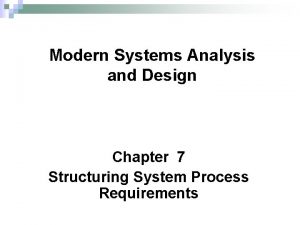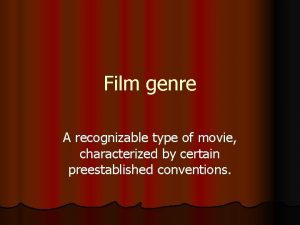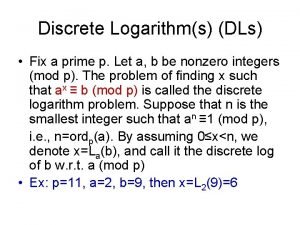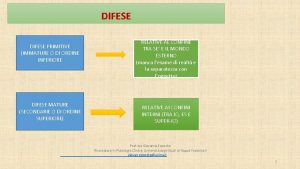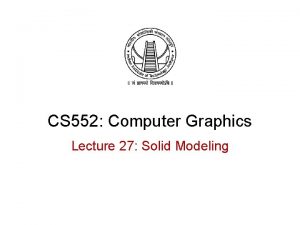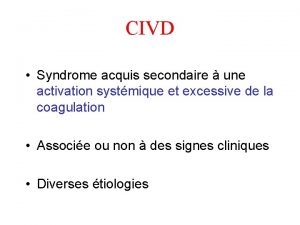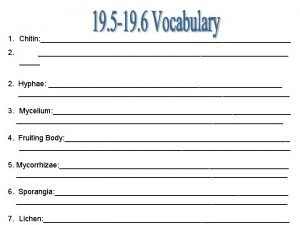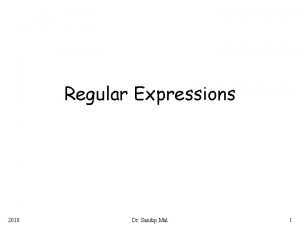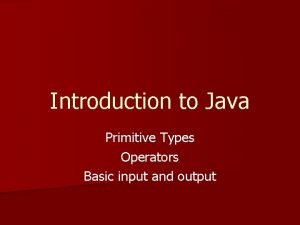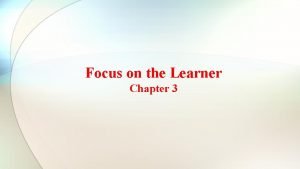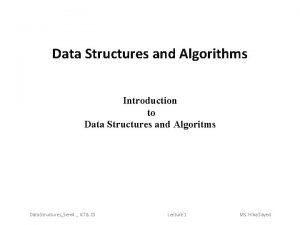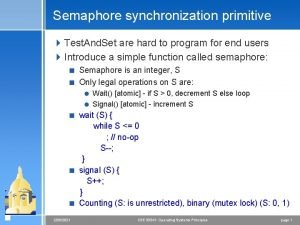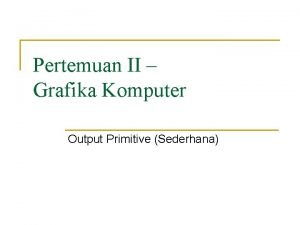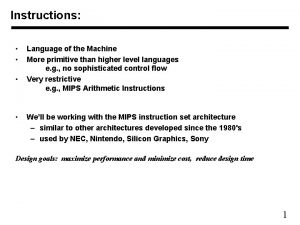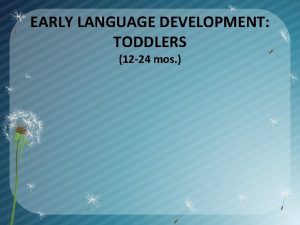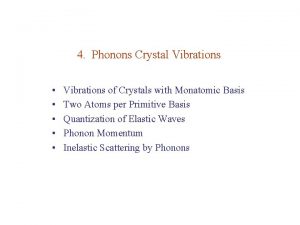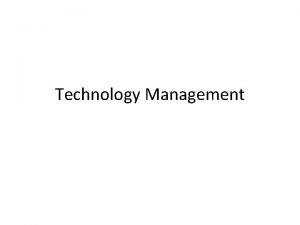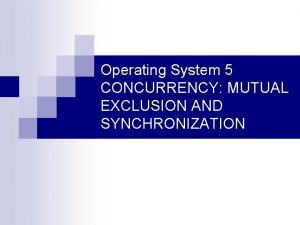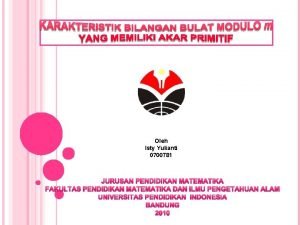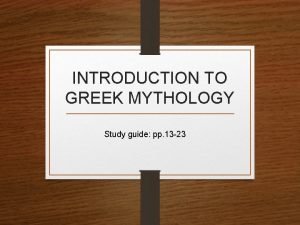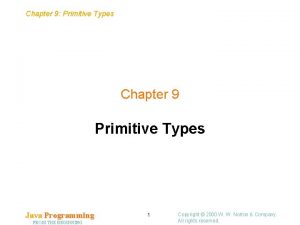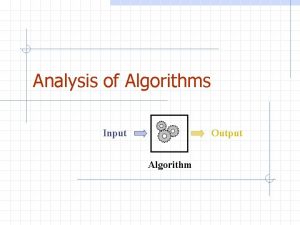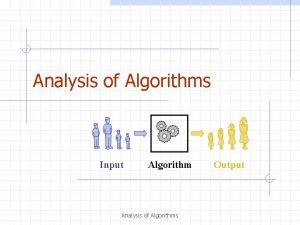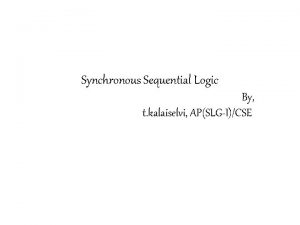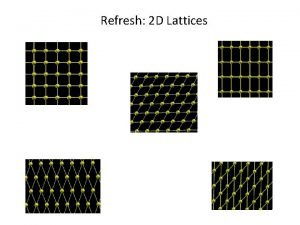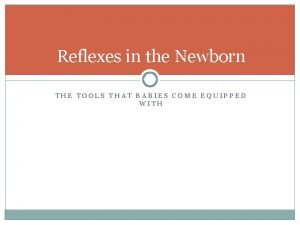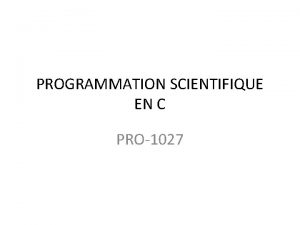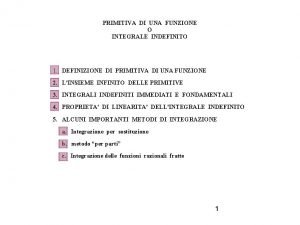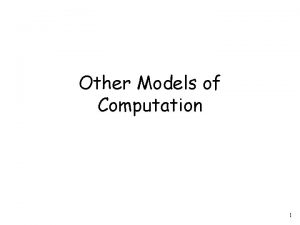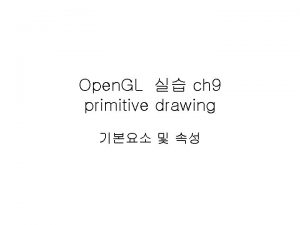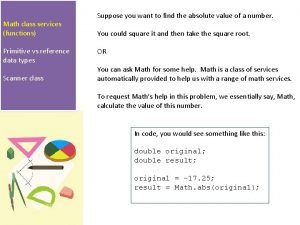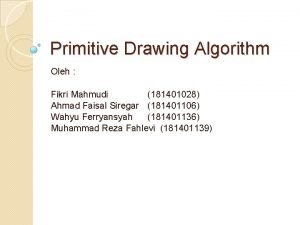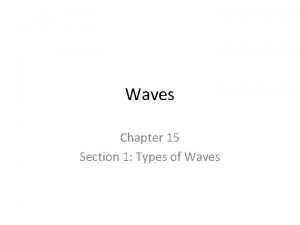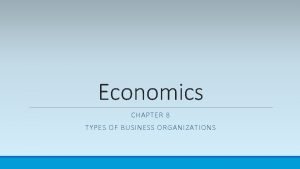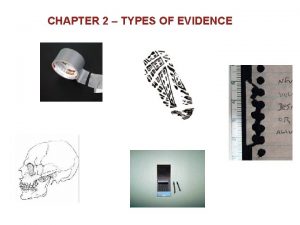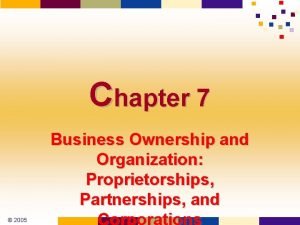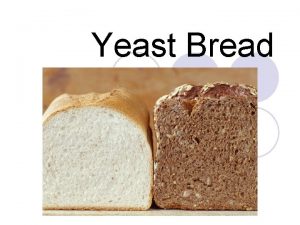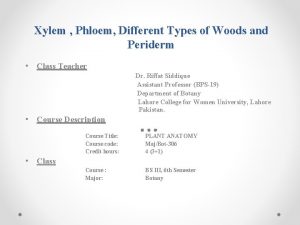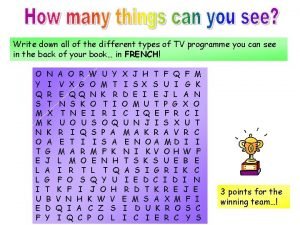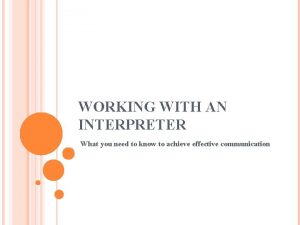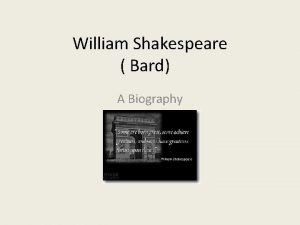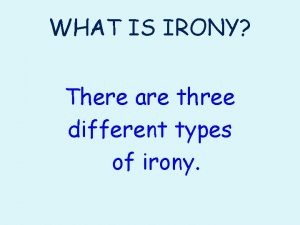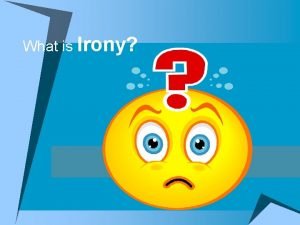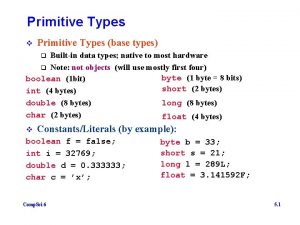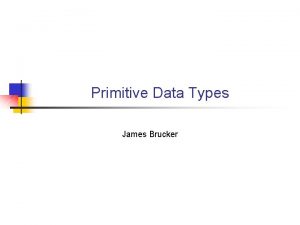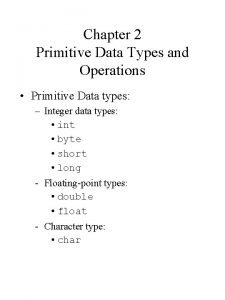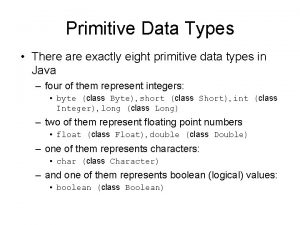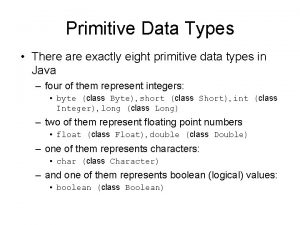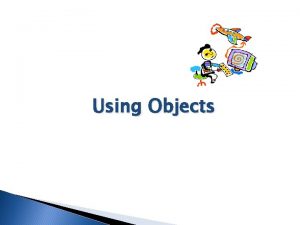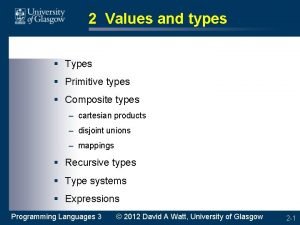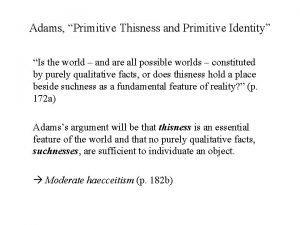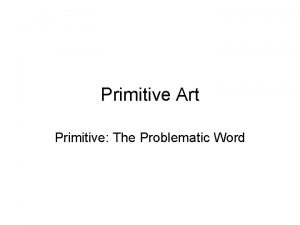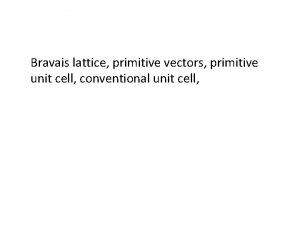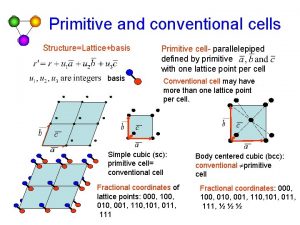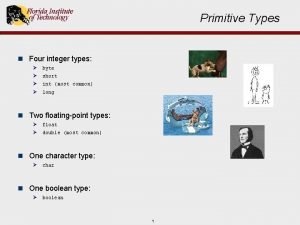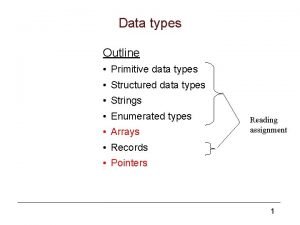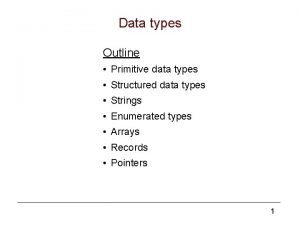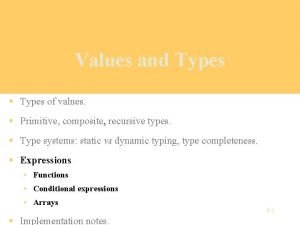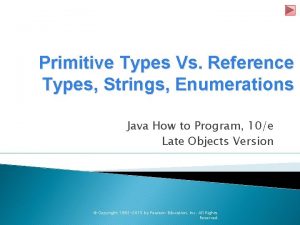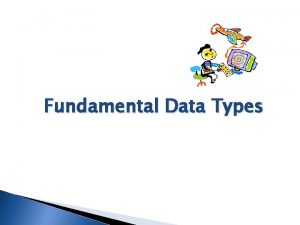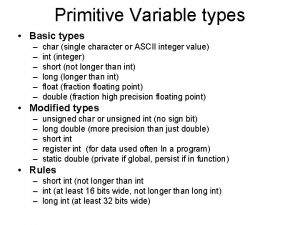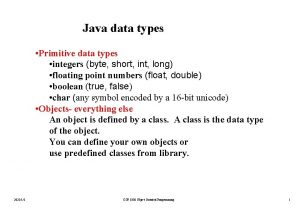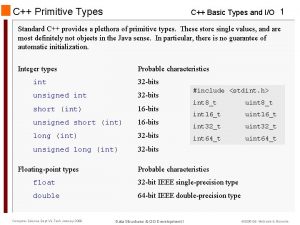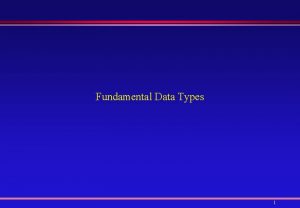Chapter 9 Primitive Types Chapter 9 Primitive Types


























































































































- Slides: 122

Chapter 9: Primitive Types Chapter 9 Primitive Types Java Programming FROM THE BEGINNING 1 Copyright © 2000 W. W. Norton & Company. All rights reserved.

Chapter 9: Primitive Types 9. 1 Types • Numbers, like all data, must be stored in computer memory. • Computer memory consists of bits (0 s and 1 s). • Bits are grouped into larger units, known as bytes, each containing eight bits. • The type of a data item determines how much space is used to store the item and how the bits in the item are interpreted. Java Programming FROM THE BEGINNING 2 Copyright © 2000 W. W. Norton & Company. All rights reserved.

Chapter 9: Primitive Types Versus Reference Types • Java has two kinds of types: primitive types and reference types. • A variable of a primitive type stores a data item directly. • A variable of a reference type stores the location of the data, not the data itself. • The primitive types fall into two categories: – Numeric (the byte, short, int, long, float, double, and char types) – Boolean (the boolean type) Java Programming FROM THE BEGINNING 3 Copyright © 2000 W. W. Norton & Company. All rights reserved.

Chapter 9: Primitive Types Literals • The representation of a particular value within a program is said to be a literal. – 12 is an int literal. – true is a boolean literal. • There’s usually no single way to represent a particular number. • Humans write the same number in different ways. The Romans wrote “twelve” as XII instead of 12. • Similarly, programmers sometimes use different literals that represent the same number. Java Programming FROM THE BEGINNING 4 Copyright © 2000 W. W. Norton & Company. All rights reserved.

Chapter 9: Primitive Types 9. 2 Integer Types • A variable of type int can store any number between – 2, 147, 483, 648 and +2, 147, 483, 647. • This unusual range of values stems from the fact that computers store numbers in binary (base 2) rather than decimal (base 10). Java Programming FROM THE BEGINNING 5 Copyright © 2000 W. W. Norton & Company. All rights reserved.

Chapter 9: Primitive Types Binary Numbers • Decimal numbers are written in a positional notation, with each digit corresponding to a power of 10: 153 = 1 102 + 5 101 + 3 100 • A binary number consists of a series of binary digits (bits), each of which is either 0 or 1. • Each bit is implicitly multiplied by a power of 2. • The binary number 1001 is equivalent to the decimal number 153: 1 27 + 0 26 + 0 25 + 1 24 + 1 23 + 0 22 + 0 21 + 1 20 = 128 + 0 + 16 + 8 + 0 + 1 = 153 Java Programming FROM THE BEGINNING 6 Copyright © 2000 W. W. Norton & Company. All rights reserved.

Chapter 9: Primitive Types Binary Numbers • Inside the computer, numbers are stored using a fixed number of bits. • The number of bits used depends on the type of the number. • A number that has int type is stored using 32 bits. • In int form, the number 153 would be stored as 0000000000001001 rather than just 1001. Java Programming FROM THE BEGINNING 7 Copyright © 2000 W. W. Norton & Company. All rights reserved.

Chapter 9: Primitive Types The Sign Bit • The leftmost bit of an integer is used to store the number’s sign. – If the leftmost bit is 0, the number is positive (or zero). – If the leftmost bit is 1, the number is negative. • Because of the presence of this sign bit, the largest int is 01111111111111111, which has the value 1 230 + 1 229 + … + 1 20 = 231 – 1 = 2, 147, 483, 647 Java Programming FROM THE BEGINNING 8 Copyright © 2000 W. W. Norton & Company. All rights reserved.

Chapter 9: Primitive Types Negative Integers • Java stores negative integers in a form known as two’s complement. • An algorithm for determining the bits in a negative number: 1. Write the positive version of the number in binary. 2. Complement the number (change each 0 bit to 1 and change each 1 bit to 0). 3. Add 1 to the result. Java Programming FROM THE BEGINNING 9 Copyright © 2000 W. W. Norton & Company. All rights reserved.

Chapter 9: Primitive Types Negative Integers • To determine how the number – 12 would be stored as an int value, the first step is to write 12 in binary: 000000000000001100 • Next, find the complement of the number: 111111111111110011 • Finally, add 1 to the complement: 111111111111110011 + 1 111111111111110100 • The sign bit is 1, indicating a negative number. Java Programming FROM THE BEGINNING 10 Copyright © 2000 W. W. Norton & Company. All rights reserved.

Chapter 9: Primitive Types Negative Integers • Desirable properties of two’s complement: – The value of N + (–N) is zero for all values of N. – The value of –(–N) is equal to N. – 0 cannot be negative. Java Programming FROM THE BEGINNING 11 Copyright © 2000 W. W. Norton & Company. All rights reserved.

Chapter 9: Primitive Types The long Type • For integers that exceed 2, 147, 483, 647, Java has another type named long, which stores integers using 64 bits. • The largest value that can be stored as a long is 263 – 1. • If that’s still not big enough, there’s a class named Big. Integer whose instances can store integers of any size whatsoever. Java Programming FROM THE BEGINNING 12 Copyright © 2000 W. W. Norton & Company. All rights reserved.

Chapter 9: Primitive Types The byte and short Types • When working with numbers that are known to be small, it’s sometimes advantageous to use a “smaller” type than int. • Java has two such types, byte and short. • A byte value is stored in 8 bits, so its values range from – 128 (– 27) to +127 (27 – 1). • A short value is stored in 16 bits; its values range from – 32, 768 (– 215) to +32, 767 (215 – 1). Java Programming FROM THE BEGINNING 13 Copyright © 2000 W. W. Norton & Company. All rights reserved.

Chapter 9: Primitive Types Summary of the Integer Types • A summary of Java’s integer types: Type Size Smallest Value Largest Value byte 8 bits – 128 127 short 16 bits – 32, 768 32, 767 int 32 bits – 2, 147, 483, 648 2, 147, 483, 647 long 64 bits – 263– 1 • Most of the time, int is the best choice. • Operations on long values may require more time than operations on int values. Java Programming FROM THE BEGINNING 14 Copyright © 2000 W. W. Norton & Company. All rights reserved.

Chapter 9: Primitive Types Portability of the Primitive Types • In most languages, the size and representation of most types aren’t completely specified, allowing the language to “fit” different computers. • In C++, an int value might be 16 bits long, 32 bits long, or some other size entirely. • Because it puts portability ahead of efficiency, Java requires that an int value be exactly 32 bits long, with one bit reserved for the number’s sign. • Java’s numeric types have fixed ranges that don’t vary from one computer to another. Java Programming FROM THE BEGINNING 15 Copyright © 2000 W. W. Norton & Company. All rights reserved.

Chapter 9: Primitive Types The Integer Classes • For each integer type, there is a corresponding class (Byte, Short, Integer, or Long) in the java. lang package. • Each class provides constants named MIN_VALUE and MAX_VALUE, which represent the smallest and largest values of the corresponding type. • For example, Byte. MIN_VALUE is – 128 and Byte. MAX_VALUE is 127. Java Programming FROM THE BEGINNING 16 Copyright © 2000 W. W. Norton & Company. All rights reserved.

Chapter 9: Primitive Types Integer Literals • Java allows integer literals to be written in decimal (base 10), octal (base 8), or hexadecimal (base 16). • Decimal literals contain digits between 0 and 9, but must not begin with a zero: 15 255 32767 • Octal literals contain only digits between 0 and 7, and must begin with a zero: 017 0377 077777 • Hexadecimal literals contain digits between 0 and 9 and letters between a and f, and always begin with 0 x: 0 xff Java Programming FROM THE BEGINNING 0 x 7 fff 17 Copyright © 2000 W. W. Norton & Company. All rights reserved.

Chapter 9: Primitive Types Integer Literals • The letters in a hexadecimal literal may be either upper or lowercase: 0 xff 0 xf. F 0 x. Ff 0 x. FF 0 Xff 0 Xf. F 0 XFf 0 XFF • Writing numbers in octal or hexadecimal has no effect on how the numbers are actually stored. • The literals 15, 017, or 0 xf all represent the same number (fifteen). • A program can switch from one notation to another at any time, and even mix them: 10 + 015 + 0 x 20 has the value 55 (decimal). Java Programming FROM THE BEGINNING 18 Copyright © 2000 W. W. Norton & Company. All rights reserved.

Chapter 9: Primitive Types Octal and Hexadecimal • An octal number is written using only the digits 0 through 7. • Each position in an octal number represents a power of 8. • The octal number 237 represents the decimal number 2 82 + 3 81 + 7 80 = 128 + 24 + 7 = 159. • A hexadecimal (or hex) number is written using the digits 0 through 9 plus the letters A through F, which stand for 10 through 15, respectively. • Each position in a hex number represents a power of 16. • The hex number 1 AF has the decimal value 1 162 + 10 161 + 15 160 = 256 + 160 + 15 = 431. Java Programming FROM THE BEGINNING 19 Copyright © 2000 W. W. Norton & Company. All rights reserved.

Chapter 9: Primitive Types Octal and Hexadecimal • Although integers are stored in binary form, humans usually prefer to work with decimal numbers. • In some types of programs, however, it’s necessary to work directly with binary numbers. • Unfortunately, writing numbers in binary is painful and error-prone. • Because of the close connection between the binary number system and the octal and hexadecimal systems, it’s easy to translate binary numbers to either octal or hexadecimal. Java Programming FROM THE BEGINNING 20 Copyright © 2000 W. W. Norton & Company. All rights reserved.

Chapter 9: Primitive Types Octal and Hexadecimal • To translate a binary number into octal, first collect the bits into groups of three, starting from the right end: 011 111 101 110 111 100 001 111 000 • Next, translate each group into a single octal digit: 0 11 111 3 5 111 101 7 6 101 110 5 4 111 100 001 111 000 7 1 7 0 7 • Finally, join the octal digits together. In this example, Copyright © 2000 W. W. Norton & Company. 21 Java Programming All rights reserved. 11111100111100011110100 (binary) is FROM THE BEGINNING

Chapter 9: Primitive Types Octal and Hexadecimal • To translate a binary number into hexadecimal, first collect the bits into groups of four, starting from the right end: 1111 0100 1101 1110 0111 1000 1111 0111 • Next, translate each group into a single hex digit: 1111 0100 F 1101 1110 0111 1000 1111 0111 D E 7 8 F 7 4 • Joining the digits together gives FDE 78 F 74 (hexadecimal), which is equivalent to Copyright © 2000 W. W. Norton & Company. 22 11111100111100011110100 (binary). Java Programming All rights reserved. FROM THE BEGINNING

Chapter 9: Primitive Types Type of an Integer Literal • By default, an integer literal has type int. • Examples of int literals: 512 0777 0 x 10000000 • A literal that ends with the letter L has type long: 512 L 0777 L 0 x 10000000 L • The L suffix can be lowercase, but that’s not a good idea—it’s too easy to confuse the letter l with the digit 1. • An integer literal whose value is greater than 2147483647 or less than – 2147483648 must have the L suffix. Java Programming FROM THE BEGINNING 23 Copyright © 2000 W. W. Norton & Company. All rights reserved.

Chapter 9: Primitive Types Converting Strings to Integers • Methods that convert a string containing an integer into the actual value of the integer: Byte. parse. Byte Integer. parse. Int Long. parse. Long Short. parse. Short • Number. Format. Exception is thrown if the string doesn’t contain a valid integer or it represents a number outside the range of allowable values. • For example, Byte. parse. Byte would reject the string "128", because the largest byte value is 127. Java Programming FROM THE BEGINNING 24 Copyright © 2000 W. W. Norton & Company. All rights reserved.

Chapter 9: Primitive Types 9. 3 Floating-Point Types • The integer types aren’t suitable for variables that need to store numbers with digits after the decimal point, or numbers that are exceedingly large or small. • Java provides two types to use in this situation: float and double, the floating-point types. • Characteristics of the floating-point types: Type float double Smallest Size Positive Value Largest Value Precision 32 bits 1. 40 10– 45 3. 40 1038 6 digits 64 bits 4. 94 10– 324 1. 79 10308 15 digits Java Programming FROM THE BEGINNING 25 Copyright © 2000 W. W. Norton & Company. All rights reserved.

Chapter 9: Primitive Types Floating-Point Types • float is suitable when accuracy isn’t critical. • double provides greater precision. • For numbers that must be stored even more precisely, Java provides a class named Big. Decimal. • In most languages, the format of floating-point numbers isn’t specified, because not all computers store floating-point numbers in the same way. • For portability, Java requires that float and double values be stored in the format specified by IEEE Standard 754. Java Programming FROM THE BEGINNING 26 Copyright © 2000 W. W. Norton & Company. All rights reserved.

Chapter 9: Primitive Types The IEEE Floating-Point Standard • IEEE Standard 754, developed by the Institute of Electrical and Electronics Engineers, provides two primary formats for floating-point numbers: – Single precision (32 bits) – Double precision (64 bits) • Numbers are stored in a form of scientific notation, with each number having three parts: – Sign – Exponent – Fraction Java Programming FROM THE BEGINNING 27 Copyright © 2000 W. W. Norton & Company. All rights reserved.

Chapter 9: Primitive Types The IEEE Floating-Point Standard • The number of bits reserved for the exponent determines how large (or small) numbers can be • The number of bits in the fraction determines the precision. • Single-precision format: – 8 -bit exponent and 23 -bit fraction – Maximum value of approximately 3. 40 1038, with a precision of about 6 decimal digits • Double-precision format: – 11 -bit exponent and 52 -bit fraction – Maximum value of approximately 1. 79 10308, with a precision of about 15 decimal digits Java Programming FROM THE BEGINNING 28 Copyright © 2000 W. W. Norton & Company. All rights reserved.

Chapter 9: Primitive Types Floating-Point Literals • When a literal represents a float or double value, it is said to be a floating-point literal. • A floating-point literal may contain a decimal point: 2. 9748 414. 270984 . 0008915 • It may have an exponent instead: 29748 e-4 414270984 e-6 8915 e-7 • Or it may have both a decimal point and an exponent: 297. 48 e-2 4. 14270984 e+2 89. 15 e-5 • The + in the exponent is optional, and the e can be uppercase. Java Programming FROM THE BEGINNING 29 Copyright © 2000 W. W. Norton & Company. All rights reserved.

Chapter 9: Primitive Types Floating-Point Literals • A floating-point literal may end with the letter f (or F), to indicate that it has type float, or it may end with d (or D), to indicate that it has type double. • By default, a floating-point literal is treated as a double value. • A floating-point literal must contain a decimal point and/or an exponent, unless f or d is appended to the literal: 597 d 597 f Java Programming FROM THE BEGINNING 30 Copyright © 2000 W. W. Norton & Company. All rights reserved.

Chapter 9: Primitive Types Floating-Point Literals • A double value can’t be assigned to a float variable. As a result, a floating-point literal without a suffix can’t be assigned to a float variable: float x; x = 1. 0; // WRONG; 1. 0 has type double • One solution is to declare x as a double variable: double x; x = 1. 0; // Legal • The other is to put the letter f at the end of the literal: float x; x = 1. 0 f; Java Programming FROM THE BEGINNING // Legal 31 Copyright © 2000 W. W. Norton & Company. All rights reserved.

Chapter 9: Primitive Types Special Values • Java’s float and double types include three special values: + , – , and Na. N (Not a Number). • Dividing a positive number by zero yields +. • Dividing a negative number by zero yields –. • Na. N is the result of a mathematically undefined operation, such as dividing zero by zero. • Examples: 1. 0 / 0. 0 + -1. 0 / 0. 0 – 0. 0 / 0. 0 Na. N Java Programming FROM THE BEGINNING 32 Copyright © 2000 W. W. Norton & Company. All rights reserved.

Chapter 9: Primitive Types Special Values • Special values can be used in computations. • + and – have much the same properties as they do in ordinary mathematics. • Dividing an ordinary floating-point number by infinity gives zero as the result: 1. 0 / (1. 0 / 0. 0) 0. 0 1. 0 / (-1. 0 / 0. 0) – 0. 0 Java Programming FROM THE BEGINNING 33 Copyright © 2000 W. W. Norton & Company. All rights reserved.

Chapter 9: Primitive Types Special Values • Using Na. N in a calculation always results in a value of Na. N: 1. 0 / (0. 0 / 0. 0) Na. N 0. 0 * (0. 0 / 0. 0) Na. N • Na. N can also result from multiplying infinity by zero: (1. 0 / 0. 0) * 0. 0 Na. N (-1. 0 / 0. 0) * 0. 0 Na. N Java Programming FROM THE BEGINNING 34 Copyright © 2000 W. W. Norton & Company. All rights reserved.

Chapter 9: Primitive Types Special Values • The java. lang package contains classes named Float and Double. • These classes provide constants named POSITIVE_INFINITY, NEGATIVE_INFINITY, and Na. N. • They also provide a method named is. Na. N that tests whether a floating-point number is Na. N. Java Programming FROM THE BEGINNING 35 Copyright © 2000 W. W. Norton & Company. All rights reserved.

Chapter 9: Primitive Types Special Values • Expressions whose values are + , – , and Na. N can be printed with System. out. print or System. out. println: System. out. println(1. 0 / 0. 0); // Prints "Infinity" System. out. println(-1. 0 / 0. 0); // Prints "-Infinity" System. out. println(0. 0 / 0. 0); // Prints "Na. N" Java Programming FROM THE BEGINNING 36 Copyright © 2000 W. W. Norton & Company. All rights reserved.

Chapter 9: Primitive Types The Math Class • The Math class, which is part of the java. lang package, provides a number of methods that are useful when working with numbers, especially floating-point numbers. • The Math class also defines two constants, named E and PI, which represent the familiar mathematical constants e and . • These constants can be accessed by writing Math. E and Math. PI. Java Programming FROM THE BEGINNING 37 Copyright © 2000 W. W. Norton & Company. All rights reserved.

Chapter 9: Primitive Types The Math Class • Seven of the methods in the Math class are capable of computing trigonometric functions. • Like most methods in the Math class, the trigonometric methods require parameters of type double and return a result of type double. • Angles are measured in radians, not degrees. • The cos, sin, and tan methods compute the cosine, and tangent functions: Math. cos(Math. PI) – 1. 0 Math. sin(Math. PI) 1. 2246467991473532 E-16 Math. tan(Math. PI) – 1. 2246467991473532 E-16 Java Programming FROM THE BEGINNING 38 Copyright © 2000 W. W. Norton & Company. All rights reserved.

Chapter 9: Primitive Types The Math Class • The acos, asin, atan, and atan 2 methods compute inverse trigonometric functions: Math. acos(1. 0) 0. 0 Math. asin(1. 0) 1. 5707963267948966 Math. atan(1. 0) 0. 7853981633974483 Math. atan 2(1. 0, 1. 0) 0. 7853981633974483 • acos returns a value between 0. 0 and . • asin and atan return values between – /2 and /2. • atan 2 returns a value between – and . Java Programming FROM THE BEGINNING 39 Copyright © 2000 W. W. Norton & Company. All rights reserved.

Chapter 9: Primitive Types The Math Class • The Math class also provides methods that compute the exponential and logarithmic functions. • The exp method computes the exponential function: Math. exp(1. 0) 2. 718284590455 • The log method computes the natural logarithm of its argument: Math. log(Math. E) 1. 0 • The log method’s argument must be greater than zero. log returns – if the argument is zero; it returns Na. N if the argument is less than zero. Java Programming FROM THE BEGINNING 40 Copyright © 2000 W. W. Norton & Company. All rights reserved.

Chapter 9: Primitive Types The Math Class • The pow and sqrt methods compute powers and square roots. • pow(a, b) throws Arithmetic. Exception if a is equal to 0. 0 and b is less than or equal to 0. 0, or if a is less than 0. 0 and b is not a whole number. • The sqrt method returns Na. N if its argument is less than zero. Java Programming FROM THE BEGINNING 41 Copyright © 2000 W. W. Norton & Company. All rights reserved.

Chapter 9: Primitive Types The Math Class • The abs, max, and min methods compute the absolute value and the maximum and minimum of two numbers. • Each method is overloaded. There actually four different methods named abs, four named max, and four named min. • One version of the abs method takes an int argument and returns an int value; the other versions take long, float, and double arguments. Java Programming FROM THE BEGINNING 42 Copyright © 2000 W. W. Norton & Company. All rights reserved.

Chapter 9: Primitive Types The Math Class • The ceil, floor, rint, and round methods are used to round float and double values to integers. • The ceil method returns the smallest integer that’s not less than the argument: Math. ceil(4. 1) 5. 0 Math. ceil(4. 9) 5. 0 Math. ceil(-4. 1) – 4. 0 Math. ceil(-4. 9) – 4. 0 Java Programming FROM THE BEGINNING 43 Copyright © 2000 W. W. Norton & Company. All rights reserved.

Chapter 9: Primitive Types The Math Class • The floor method returns the largest integer that’s not greater than the argument: Math. floor(4. 1) 4. 0 Math. floor(4. 9) 4. 0 Math. floor(-4. 1) – 5. 0 Math. floor(-4. 9) – 5. 0 Java Programming FROM THE BEGINNING 44 Copyright © 2000 W. W. Norton & Company. All rights reserved.

Chapter 9: Primitive Types The Math Class • The rint method returns the integer closest to the argument: Math. rint(4. 1) 4. 0 Math. rint(4. 5) 4. 0 Math. rint(4. 9) 5. 0 Math. rint(5. 5) 6. 0 Math. rint(-4. 1) – 4. 0 Math. rint(-4. 5) – 4. 0 Math. rint(-4. 9) – 5. 0 Math. rint(-5. 5) – 6. 0 • If the argument to rint is equally close to two integers, rint returns the even one. Java Programming FROM THE BEGINNING 45 Copyright © 2000 W. W. Norton & Company. All rights reserved.

Chapter 9: Primitive Types The Math Class • The two round methods behave exactly like rint; the only difference is that they return int or long values instead of double values. • One version of rounds a float value to the nearest int value; the other rounds a double value to the nearest long value. • The Math class also provides the random method, which returns a pseudorandom double value that’s greater than or equal to 0. 0 and less than 1. 0. Java Programming FROM THE BEGINNING 46 Copyright © 2000 W. W. Norton & Company. All rights reserved.

Chapter 9: Primitive Types Pseudorandom Numbers • Programs that play games or simulate real-world phenomena often need a source of numbers that appear to be random. • Truly random numbers are hard to come by, so programmers settle for pseudorandom numbers. • Pseudorandom numbers appear to be random but are actually generated by a mathematical formula. • A pseudorandom sequence begins with a seed value; each value after that in the sequence is generated from the previous value. Java Programming FROM THE BEGINNING 47 Copyright © 2000 W. W. Norton & Company. All rights reserved.

Chapter 9: Primitive Types Pseudorandom Numbers • Pseudorandom numbers have one advantage over truly random numbers: a pseudorandom sequence can be reproduced by starting with the same seed. • The most popular method for generating pseudorandom numbers, the linear congruential method, uses the following formula: Xn+1 = (a. Xn + c) mod m Xn is the nth element in the sequence and a, c, and m are constants. • Proper choice of a, c, and m is important, to avoid having the sequence begin repeating too soon. Java Programming FROM THE BEGINNING 48 Copyright © 2000 W. W. Norton & Company. All rights reserved.

Chapter 9: Primitive Types Pseudorandom Numbers • Math. random uses the linear congruential method to generate a 53 -bit integer, which is divided by 253 to produce a double value between 0. 0 and 1. 0. • The seed is based on the time of day at which the program is run, so the pseudorandom sequence will probably be different each time. • Math. random uses the services of the Random class, which belongs to the java. util package. • An instance of the Random class keeps track of a single pseudorandom sequence. Java Programming FROM THE BEGINNING 49 Copyright © 2000 W. W. Norton & Company. All rights reserved.

Chapter 9: Primitive Types 9. 4 The char Type • A variable of type char can be assigned any single character: char ch; ch ch = = 'a'; 'A'; '0'; ' '; // // Lowercase a Uppercase A Zero Space • Character literals are enclosed in single quotes. Java Programming FROM THE BEGINNING 50 Copyright © 2000 W. W. Norton & Company. All rights reserved.

Chapter 9: Primitive Types The ASCII Character Set • A character set is a list of characters together with a unique code for each character. • The most widely used character set is ASCII (American Standard Code for Information Interchange). • There are 128 characters in ASCII. • The space character (character 32) precedes the digits (48– 57). • The uppercase letters (65– 90) come later, before the lowercase letters (97– 122). Java Programming FROM THE BEGINNING 51 Copyright © 2000 W. W. Norton & Company. All rights reserved.

Chapter 9: Primitive Types The ASCII Character Set • The first 32 characters in ASCII (and the last character, del) are control characters. • Control characters can’t be displayed on the screen or printed. • They represent commands entered by the user or commands to be sent to an output device, such as a printer. • The characters other than the control characters and the space character are said to be printing characters. Java Programming FROM THE BEGINNING 52 Copyright © 2000 W. W. Norton & Company. All rights reserved.

Chapter 9: Primitive Types The ASCII Character Set • Control characters can be entered at the keyboard by pressing special keys such as Backspace and Tab. • Control characters can also be entered by holding down the Control key and pressing a letter key. • Because the largest ASCII value is 127, the code for any ASCII character fits in a single 8 -bit byte. • For example, the character A is stored as 01000001, which is 65 in decimal or 101 in octal. Java Programming FROM THE BEGINNING 53 Copyright © 2000 W. W. Norton & Company. All rights reserved.

Chapter 9: Primitive Types The Unicode Character Set • Instead of relying on ASCII to represent characters, Java uses a slightly different encoding known as Unicode. • A Unicode character requires 16 bits. • Unicode is compatible with ASCII. Adding eight zero bits to the beginning of the ASCII code for a character gives the character’s value in Unicode. • For example, the Unicode version of the character A would be 000001000001. Java Programming FROM THE BEGINNING 54 Copyright © 2000 W. W. Norton & Company. All rights reserved.

Chapter 9: Primitive Types The Unicode Character Set • The first 256 characters of Unicode match the Latin 1 character set. • Latin 1 is an extension of ASCII that includes the characters needed by European languages (such as é, ñ, and ô) plus a number of common symbols. • Programs that need only ASCII (the first 128 characters of Unicode) or Latin 1 can simply ignore the other Unicode characters. Java Programming FROM THE BEGINNING 55 Copyright © 2000 W. W. Norton & Company. All rights reserved.

Chapter 9: Primitive Types The Unicode Character Set • A graphical depiction of the relationship between ASCII, Latin 1, and Unicode: Java Programming FROM THE BEGINNING 56 Copyright © 2000 W. W. Norton & Company. All rights reserved.

Chapter 9: Primitive Types The Unicode Character Set • Unicode can support up to 65, 536 characters. • Unicode contains the characters needed by all modern languages. • Java relies on Unicode both for writing programs and for storing character data within a program. • Although the use of Unicode is increasing rapidly, ASCII is still by far the most popular character set. • Some computers rely on even older character sets. • IBM mainframes use an 8 -bit character set named EBCDIC. Java Programming FROM THE BEGINNING 57 Copyright © 2000 W. W. Norton & Company. All rights reserved.

Chapter 9: Primitive Types Escape Sequences • A character literal is usually one character enclosed in single quotes. • Special characters, including control characters, can’t be represented in this way. • To include a special character in a literal, an escape sequence must be used. • Escape sequences can be enclosed in single quotes to form character literals or embedded in string literals. Java Programming FROM THE BEGINNING 58 Copyright © 2000 W. W. Norton & Company. All rights reserved.

Chapter 9: Primitive Types Escape Sequences • Escape sequences for use in character and string literals: Name Escape Sequence Backspace b Form feed f Line feed n Carriage return r Horizontal tab t Backslash \ Single quote ' Double quote " Octal escape �–377 Java Programming FROM THE BEGINNING 59 Copyright © 2000 W. W. Norton & Company. All rights reserved.

Chapter 9: Primitive Types Octal Escapes • Octal escapes can be used to represent any character whose Unicode value lies between 0 and 377 (octal). • An octal escape consists of the character followed by an octal number with at most three digits. • The octal code for the escape character (the character produced when the user presses the Esc key) is 33; the octal escape for this character would be 33 or �33. Java Programming FROM THE BEGINNING 60 Copyright © 2000 W. W. Norton & Company. All rights reserved.

Chapter 9: Primitive Types Unicode Escapes • Java also provides Unicode escapes, which have the form udddd, where each d is a hex digit. • Unlike the other kinds of escapes, Unicode escapes are allowed anywhere in a program, not just in character and string literals. • This property allows the use of Unicode characters in identifiers and comments. • In particular, identifiers may contain letters and digits from other languages. Java Programming FROM THE BEGINNING 61 Copyright © 2000 W. W. Norton & Company. All rights reserved.

Chapter 9: Primitive Types Operations on Characters • Java treats characters as integers. • The codes for Unicode characters range from 00000000 to 11111111, which can be thought of as the integers from 0 to 65, 535. • The character 'a' has the value 97, 'A' has the value 65, '0' has the value 48, and ' ' has the value 32. • Java considers char to be one of the integral types, along with byte, short, int, and long. Java Programming FROM THE BEGINNING 62 Copyright © 2000 W. W. Norton & Company. All rights reserved.

Chapter 9: Primitive Types Operations on Characters • When a character appears in a computation, Java simply uses its integer value: int i = 'a'; char ch = 65; ch++; // i is now 97 // ch is now 'A' // ch is now 'B' • Characters can be compared, just as numbers can: if ('a' <= ch && ch <= 'z') … • Comparisons such as 'a' <= ch are done using the integer values of the characters involved. Java Programming FROM THE BEGINNING 63 Copyright © 2000 W. W. Norton & Company. All rights reserved.

Chapter 9: Primitive Types Operations on Characters • A character variable can be used as the controlling expression in a switch statement: switch (letter) { case 'a': case 'e': case 'i': case 'o': case 'u': System. out. println("Vowel"); break; case 'y': System. out. println("Possible vowel"); break; default: System. out. println("Consonant"); break; } Java Programming FROM THE BEGINNING 64 Copyright © 2000 W. W. Norton & Company. All rights reserved.

Chapter 9: Primitive Types Operations on Characters • A character variable can be used as a loop counter: for (char ch = 'A'; ch <= 'Z'; ch++) … • Although treating characters as numbers is convenient, there are disadvantages as well. – It is possible to write meaningless expressions such as 'a' * 'b' / 'c'. – A bug caused by accidentally using a character as a number won’t be caught by the Java compiler. Java Programming FROM THE BEGINNING 65 Copyright © 2000 W. W. Norton & Company. All rights reserved.

Chapter 9: Primitive Types Characters Versus Strings • A character stored in a String object can be retrieved by calling the char. At method. • char. At requires a single argument, representing the position of the desired character. • A loop that visits all the characters in a string: for (int i = 0; i < str. length(); i++) … Inside the loop, the call str. char. At(i) would be used to access the character at position i. Java Programming FROM THE BEGINNING 66 Copyright © 2000 W. W. Norton & Company. All rights reserved.

Chapter 9: Primitive Types Characters Versus Strings • A loop that displays an ISBN number with the dashes removed. for (int i = 0; i < isbn. length(); i++) { char ch = isbn. char. At(i); if (ch != '-') System. out. print(ch); } Java Programming FROM THE BEGINNING 67 Copyright © 2000 W. W. Norton & Company. All rights reserved.

Chapter 9: Primitive Types The Character Class • The Character class, which belongs to the java. lang package, provides methods for testing and converting characters. • is. Digit checks whether its argument is a digit: Character. is. Digit('a') false Character. is. Digit('0') true Character. is. Digit(' ') false • is. ISOControl checks whether its argument is a control character: Character. is. ISOControl('a') false Character. is. ISOControl('0') false Character. is. ISOControl('n') true Java Programming FROM THE BEGINNING 68 Copyright © 2000 W. W. Norton & Company. All rights reserved.

Chapter 9: Primitive Types The Character Class • is. Letter checks whether its argument is a letter: Character. is. Letter('a') true Character. is. Letter('0') false Character. is. Letter(' ') false • is. Letter. Or. Digit checks whether its argument is a letter or a digit: Character. is. Letter. Or. Digit('a') true Character. is. Letter. Or. Digit('0') true Character. is. Letter. Or. Digit(' ') false • “Letters” and “digits” include all Unicode letters and digits, not just the characters from A to Z and 0 to 9. Java Programming FROM THE BEGINNING 69 Copyright © 2000 W. W. Norton & Company. All rights reserved.

Chapter 9: Primitive Types The Character Class • is. Lower. Case checks whether its argument is a lowercase letter: Character. is. Lower. Case('a') true Character. is. Lower. Case('A') false • is. Upper. Case checks whether its argument is an uppercase letter: Character. is. Upper. Case('a') false Character. is. Upper. Case('A') true Java Programming FROM THE BEGINNING 70 Copyright © 2000 W. W. Norton & Company. All rights reserved.

Chapter 9: Primitive Types The Character Class • is. Whitespace checks whether its argument is a white-space character—a character that’s invisible to the user. • Some control characters—including the tab character and the line feed—are white-space characters, as is the space character itself. Character. is. Whitespace('a') false Character. is. Whitespace(' ') true Character. is. Whitespace('n') true Java Programming FROM THE BEGINNING 71 Copyright © 2000 W. W. Norton & Company. All rights reserved.

Chapter 9: Primitive Types The Character Class • When given a character ch and a radix as its arguments, the digit method returns the integer equivalent of ch: Character. digit('5', Character. digit('A', Character. digit('f', 8) 5 10) 5 16) 10 16) 15 • If the radix is illegal (not between 2 and 36) or ch is not a legal digit in the specified radix, digit returns – 1. Java Programming FROM THE BEGINNING 72 Copyright © 2000 W. W. Norton & Company. All rights reserved.

Chapter 9: Primitive Types The Character Class • The for. Digit method converts an integer in a specified radix to a single-digit character: Character. for. Digit(5, 8) '5' Character. for. Digit(5, 10) '5' Character. for. Digit(10, 16) 'a' Character. for. Digit(15, 16) 'f' • If the radix isn’t between 2 and 36 or the integer to be converted isn’t between 0 and radix – 1, for. Digit returns the null character. • The null character is the character whose integer code is 0. Java Programming FROM THE BEGINNING 73 Copyright © 2000 W. W. Norton & Company. All rights reserved.

Chapter 9: Primitive Types The Character Class • to. Lower. Case accepts any character as its argument. If the argument is an uppercase letter, the lowercase version of the letter is returned; otherwise, the argument itself is returned: Character. to. Lower. Case('a') 'a' Character. to. Lower. Case('A') 'a' Character. to. Lower. Case('5') '5' • to. Upper. Case is similar: Character. to. Upper. Case('a') 'A' Character. to. Upper. Case('A') 'A' Character. to. Upper. Case('5') '5' Java Programming FROM THE BEGINNING 74 Copyright © 2000 W. W. Norton & Company. All rights reserved.

Chapter 9: Primitive Types 9. 5 Type Conversion • For a computer to perform an arithmetic operation, the operands must usually be of the same size and be stored in the same way. • Java, however, allows primitive types to be mixed in expressions. • The Java compiler may have to generate instructions that convert operands to different types so that the hardware will be able to evaluate the expression. Java Programming FROM THE BEGINNING 75 Copyright © 2000 W. W. Norton & Company. All rights reserved.

Chapter 9: Primitive Types Implicit Versus Explicit Conversions • Examples: – If an int is added to a long, the compiler will arrange for the int value to be converted to 64 bits. – If an int and a float are added, the compiler will arrange for the int to be converted to float format. • The compiler handles these conversions automatically, so they’re known as implicit conversions. • Java also allows the programmer to perform explicit conversions. Java Programming FROM THE BEGINNING 76 Copyright © 2000 W. W. Norton & Company. All rights reserved.

Chapter 9: Primitive Types Implicit Conversions • Situations in which implicit conversions are performed: – When the operands in a numeric expression don’t have the same type. – When the type of the expression on the right side of an assignment doesn’t match the type of the variable on the left side. – When the type of an argument in a method call doesn’t match the type of the corresponding parameter. – When a value needs to be converted to string form (as in the expression "THX" + 1138). Java Programming FROM THE BEGINNING 77 Copyright © 2000 W. W. Norton & Company. All rights reserved.

Chapter 9: Primitive Types Numeric Promotion • Many Java operators allow operands of different types. If the operands have different types, they must be converted to some common type before the operation can be performed. • If f is a float variable and i is an int variable, it’s safer to convert i to type float rather than convert f to type int. • Java’s strategy is to convert operands to a type that will safely accommodate both values. • This process is called numeric promotion. Java Programming FROM THE BEGINNING 78 Copyright © 2000 W. W. Norton & Company. All rights reserved.

Chapter 9: Primitive Types Numeric Promotion • Rules for numeric promotion: 1. If either operand is of type double, the other is converted to double. 2. If either operand is of type float, the other is converted to float. 3. If either operand is of type long, the other is converted to long. 4. Otherwise, both operands are converted to int. Java Programming FROM THE BEGINNING 79 Copyright © 2000 W. W. Norton & Company. All rights reserved.

Chapter 9: Primitive Types Numeric Promotion • Examples: double + int double int + double float + int float long + float short + long byte + int short + byte int Java Programming FROM THE BEGINNING 80 Copyright © 2000 W. W. Norton & Company. All rights reserved.

Chapter 9: Primitive Types Numeric Promotion • Numeric promotion tries to change the way a number is stored, without changing the number’s value. • However, when converting from int or long to float, or from long to double, some of the original number’s precision may be lost. Java Programming FROM THE BEGINNING 81 Copyright © 2000 W. W. Norton & Company. All rights reserved.

Chapter 9: Primitive Types Numeric Promotion • The numeric promotions are applied to the operands of most binary operators, including: – – Multiplicative operators (*, /, and %) Additive operators (+ and -) Relational operators (<, <=, >, and >=) Equality operators (== and !=) Java Programming FROM THE BEGINNING 82 Copyright © 2000 W. W. Norton & Company. All rights reserved.

Chapter 9: Primitive Types Conversion During Assignment • In an assignment, Java converts the expression on the right side to the type of the variable on the left side, provided that the variable’s type is at least as “wide” as the expression’s type. • The numeric types, in order of increasing width: Java Programming FROM THE BEGINNING 83 Copyright © 2000 W. W. Norton & Company. All rights reserved.

Chapter 9: Primitive Types Conversion During Assignment • Examples of legal assignments: short s; int i; float f; double d; … i = s; // s is converted to int f = i; // i is converted to float d = f; // f is converted to double • In addition, a char value can be assigned to a variable of type int, long, float, or double. Java Programming FROM THE BEGINNING 84 Copyright © 2000 W. W. Norton & Company. All rights reserved.

Chapter 9: Primitive Types Conversion During Assignment • An assignment in which the expression on the right side has a wider type than the variable on the left side is an error: int i; float f; … i = f; // WRONG • The reason for this rule is that storing a value into a narrower variable can cause bugs in the program. Java Programming FROM THE BEGINNING 85 Copyright © 2000 W. W. Norton & Company. All rights reserved.

Chapter 9: Primitive Types Conversion During Assignment • Because int values can’t be assigned to byte and short variables, the following statements appear to be illegal: byte b = 10; short s = 127; • In fact, these statements are legal, thanks to a loophole in Java’s rules for assignment. • An int expression can be assigned to a byte, short, or char variable, provided that (a) the expression is constant and (b) the expression has a value that’s legal for the variable. Java Programming FROM THE BEGINNING 86 Copyright © 2000 W. W. Norton & Company. All rights reserved.

Chapter 9: Primitive Types Argument Conversion • When a method is called, Java will try to convert each argument of a primitive type to the type of the corresponding parameter. • Example: acct. deposit(100); The argument will be converted to double, the type of the parameter for the deposit method. Java Programming FROM THE BEGINNING 87 Copyright © 2000 W. W. Norton & Company. All rights reserved.

Chapter 9: Primitive Types Argument Conversion • The rules for converting arguments are nearly the same as the rules for conversion during assignment. • Java converts each argument to the type of the matching parameter, provided that the parameter’s type is at least as “wide” as the argument's type. • If a method has a byte, short, or char parameter, however, the argument can’t be an integer literal (or any integer constant expression). Java Programming FROM THE BEGINNING 88 Copyright © 2000 W. W. Norton & Company. All rights reserved.

Chapter 9: Primitive Types Casting • A conversion that’s done at the programmer’s request is called a cast. • Casting is done by enclosing the desired type in parentheses and inserting it before the expression: int i; float f; … i = (int) f; // Cast f to int type • Casting a floating-point number to an integer type causes the number to be truncated. • General form of a cast: ( type-name ) expression Java Programming FROM THE BEGINNING 89 Copyright © 2000 W. W. Norton & Company. All rights reserved.

Chapter 9: Primitive Types Truncating a Floating-Point Number • Casting can be used to find the fractional part of a floating-point number: float f, fractional. Part; … fractional. Part = f - (long) f; Using long rather than int reduces the chance that f is too large to represent as an integer. • Casting can also be used to test whether a floatingpoint variable x contains an integer value: if (x == (long) x) … Java Programming FROM THE BEGINNING 90 Copyright © 2000 W. W. Norton & Company. All rights reserved.

Chapter 9: Primitive Types Truncating a Floating-Point Number • Truncating a floating-point number is useful for generating pseudorandom integers. • The Math. random method generates a random floating-point number between 0. 0 and 1. 0, which can be scaled to any range of integer values. • A statement that generates a random integer between 0 and 9: int random. Integer = (int) (Math. random() * 10); Java Programming FROM THE BEGINNING 91 Copyright © 2000 W. W. Norton & Company. All rights reserved.

Chapter 9: Primitive Types Dividing Integers Without Truncation • When integers are divided, the result is truncated, even when the result is assigned to a float or double variable: double quotient; int dividend, divisor; … quotient = dividend / divisor; • To avoid truncation, a cast expression can be used: quotient = (double) dividend / divisor; Java Programming FROM THE BEGINNING 92 Copyright © 2000 W. W. Norton & Company. All rights reserved.

Chapter 9: Primitive Types Dividing Integers Without Truncation • Java regards ( type-name ) as a unary operator. • Unary operators have higher precedence than binary operators, so the compiler interprets the expression (double) dividend / divisor as ((double) dividend) / divisor • divisor doesn’t need a cast because casting dividend to double forces the compiler to convert divisor to double also. Java Programming FROM THE BEGINNING 93 Copyright © 2000 W. W. Norton & Company. All rights reserved.

Chapter 9: Primitive Types Dividing Integers Without Truncation • Division of integers can also be done using the statement quotient = dividend / (double) divisor; or the statement quotient = (double) dividend / (double) divisor; Java Programming FROM THE BEGINNING 94 Copyright © 2000 W. W. Norton & Company. All rights reserved.

Chapter 9: Primitive Types Avoiding Overflow • An arithmetic operation may cause overflow to occur, even when the result is assigned to a variable that’s wide enough to store the correct result: long i; int j = 1000000; i = j * j; // WRONG • Using a cast avoids the problem: i = (long) j * j; • The following statement wouldn’t work, because the overflow would occur before the cast: i = (long) (j * j); Java Programming FROM THE BEGINNING // WRONG 95 Copyright © 2000 W. W. Norton & Company. All rights reserved.

Chapter 9: Primitive Types Performing Arithmetic on byte, short, and char Values • Arithmetic on byte values doesn’t always work as expected: byte a, b, c; … c = a * b; // WRONG a and b are promoted to int before the multiplication, so the result has type int. • A cast can be used to fix the problem: c = (byte) (a * b); // Legal • The same problem occurs when arithmetic is performed on short values or char variables. Java Programming FROM THE BEGINNING 96 Copyright © 2000 W. W. Norton & Company. All rights reserved.

Chapter 9: Primitive Types Program: Encrypting a Message Using the Rot 13 Technique • The “rot 13” method is one of the simplest (but least effective!) ways to encrypt a message. • This algorithm replaces each letter in the original message by the letter that comes 13 places after it in the alphabet: A B C D E F G H I J K L M N O P Q R S T U VW X Y Z N O P Q R S T UVWX Y Z A B C D E F G H I J K L M • There’s no letter 13 places after N, so it’s necessary to “wrap around” to the beginning of the alphabet. Rot 13 is an abbreviation for “rotate alphabet 13 places. ” Java Programming FROM THE BEGINNING 97 Copyright © 2000 W. W. Norton & Company. All rights reserved.

Chapter 9: Primitive Types User Interface • The Rot 13 program will ask the user for a message and then display an encrypted version of the message: Enter message to be encrypted: The truth is out there Encrypted message: Gur gehgu vf bhg gurer • One of the useful properties of the rot 13 method is that a message can be decrypted by applying the same algorithm to the encrypted message. • If Rot 13 is given the encrypted message as its input, it will display the original message: Enter message to be encrypted: Gur gehgu vf bhg gurer Encrypted message: The truth is out there Java Programming FROM THE BEGINNING 98 Copyright © 2000 W. W. Norton & Company. All rights reserved.

Chapter 9: Primitive Types Design of the Rot 13 Program • The program will need a loop that visits each character in the user’s message, using the char. At method to extract characters one by one. • An algorithm for encrypting each character: 1. If the character is not a letter, leave it unchanged. 2. If the character is an uppercase letter, replace it by the uppercase letter that’s 13 positions after it in the alphabet, wrapping to the beginning of the alphabet if necessary. 3. If the character is a lowercase letter, replace it by the lowercase letter that’s 13 positions after it in the alphabet, wrapping to the beginning of the alphabet if necessary. Java Programming FROM THE BEGINNING 99 Copyright © 2000 W. W. Norton & Company. All rights reserved.

Chapter 9: Primitive Types Design of the Rot 13 Program • Character. is. Letter and Character. is. Upper. Case can be used to test whether a character is a letter or an uppercase letter. • Replacing a letter by the one that’s 13 positions after in the alphabet can be done by adding 13 to the letter. • However, the problem of “wrap-around” must be dealt with. Java Programming FROM THE BEGINNING 100 Copyright © 2000 W. W. Norton & Company. All rights reserved.

Chapter 9: Primitive Types Design of the Rot 13 Program • One way to solve this problem would be to use an if statement. • With the help of the % operator, however, it’s possible to write a single formula that handles all letters between A and Z. • Suppose that ch is an uppercase letter. (The technique will be similar for lowercase letters. ) • Subtracting 'A' from ch gives a number between 0 and 25: ch - 'A' Java Programming FROM THE BEGINNING 101 Copyright © 2000 W. W. Norton & Company. All rights reserved.

Chapter 9: Primitive Types Design of the Rot 13 Program • Adding 13 gives a number between 13 and 38: (ch - 'A') + 13 • Applying the remainder operator produces a number between 0 and 25 : ((ch - 'A') + 13) % 26 • Adding the letter 'A' converts back to a Unicode value: ((ch - 'A') + 13) % 26 + 'A' • The cast operator converts the expression to type char: (char) (((ch - 'A') + 13) % 26 + 'A') Java Programming FROM THE BEGINNING 102 Copyright © 2000 W. W. Norton & Company. All rights reserved.

Chapter 9: Primitive Types Rot 13. java // Uses the "rot 13" algorithm to encrypt a message entered by // the user import jpb. *; public class Rot 13 { public static void main(String[] args) { // Prompt the user to enter the message to be encrypted Simple. IO. prompt("Enter message to be encrypted: "); String user. Input = Simple. IO. read. Line(); // Display the encrypted message System. out. print("Encrypted message: "); for (int i = 0; i < user. Input. length(); i++) System. out. print(encrypt(user. Input. char. At(i))); System. out. println(); } Java Programming FROM THE BEGINNING 103 Copyright © 2000 W. W. Norton & Company. All rights reserved.

Chapter 9: Primitive Types // Returns the encrypted version of ch using the "rot 13" // algorithm private static char encrypt(char ch) { if (!Character. is. Letter(ch)) return ch; if (Character. is. Upper. Case(ch)) return (char) (((ch - 'A') + 13) % 26 + 'A'); return (char) (((ch - 'a') + 13) % 26 + 'a'); } } Java Programming FROM THE BEGINNING 104 Copyright © 2000 W. W. Norton & Company. All rights reserved.

Chapter 9: Primitive Types 9. 6 Case Study: Drawing Random Circles • The Random. Circles program will draw randomly generated circles within a frame. • Each circle will consist of 360 lines that share a common endpoint (the center of the circle). • The program will use a “delay” to slow down the drawing process so that the user can see each circle being drawn. • This is an example of animation—changing the on -screen image at regular intervals to create the illusion of motion. Java Programming FROM THE BEGINNING 105 Copyright © 2000 W. W. Norton & Company. All rights reserved.

Chapter 9: Primitive Types User Interface • The user will enter the size of the frame, the number of circles to be drawn, and the “delay time, ” which controls the drawing speed: Enter frame size: 300 Enter number of circles: 10 Enter delay (in milliseconds): 5 Java Programming FROM THE BEGINNING 106 Copyright © 2000 W. W. Norton & Company. All rights reserved.

Chapter 9: Primitive Types User Interface • The program will ask the user to re-enter any input value that is not a valid integer: Enter frame size: whatever Not an integer; try again. Enter frame size: 300 Enter number of circles: a bunch Not an integer; try again. Enter number of circles: 10 Enter delay (in milliseconds): 5 Java Programming FROM THE BEGINNING 107 Copyright © 2000 W. W. Norton & Company. All rights reserved.

Chapter 9: Primitive Types Program Behavior • After the user has successfully entered all three input values, the program will display a frame. • The width and height of the drawable portion of the frame will match the size entered by the user. • The program will draw a series of circles, each with a random location, radius, and color. • The lines in each circle will be drawn in clockwise order, starting at the 12 o’clock position. • The delay time entered by the user will determine the amount of delay between successive lines. Java Programming FROM THE BEGINNING 108 Copyright © 2000 W. W. Norton & Company. All rights reserved.

Chapter 9: Primitive Types Program Behavior • A snapshot of the frame after four circles have been drawn and the fifth is currently being drawn: Java Programming FROM THE BEGINNING 109 Copyright © 2000 W. W. Norton & Company. All rights reserved.

Chapter 9: Primitive Types Program Behavior • The frame after 10 circles have been drawn: Java Programming FROM THE BEGINNING 110 Copyright © 2000 W. W. Norton & Company. All rights reserved.

Chapter 9: Primitive Types Design of the Random. Circles Program • An initial design for the program: 1. Prompt the user to enter the frame size, the number of circles, and the delay. 2. Create a frame titled “Random Circles” and set its size to the value entered by the user. 3. Get the frame’s graphics context. 4. Draw a series of circles. • A helper method named read. Int will read each input value as a string and convert it to an int value. • If Number. Format. Exception occurs, read. Int will ask the user to re-enter the input value. Java Programming FROM THE BEGINNING 111 Copyright © 2000 W. W. Norton & Company. All rights reserved.

Chapter 9: Primitive Types Design of the Random. Circles Program • Steps 2 and 3 are easy. Step 4 can be written as a method named Draw. All. Circles. This method will contain a loop that executes once for each circle. • A design for the loop body: 1. Select a color in which each component is a random number between 0 and 255. 2. Select a random radius between 0 and frame. Size/4, where frame. Size is the frame size chosen by the user; call this radius. 3. Select a random center whose coordinates fall between radius and frame. Size - radius. 4. Display a circle with the chosen center, radius, and color. Java Programming FROM THE BEGINNING 112 Copyright © 2000 W. W. Norton & Company. All rights reserved.

Chapter 9: Primitive Types Design of the Random. Circles Program • Steps 1 through 3 are easy to do with the help of the Math. random method. Step 4 will be done by a helper method named Draw. One. Circle. • After setting the drawing color, Draw. One. Circle will need to display 360 lines inside a loop. • A design for the loop body: 1. Compute the coordinates of the current line’s endpoint (the one at the edge of the circle). 2. Draw a line from the center of the circle to the edge of the circle. 3. Call repaint to update the screen. 4. Pause between successive lines. Java Programming FROM THE BEGINNING 113 Copyright © 2000 W. W. Norton & Company. All rights reserved.

Chapter 9: Primitive Types Design of the Random. Circles Program • Computing the coordinates of the current line’s endpoint will require converting the line’s angle from degrees to radians, then using the Math. cos and Math. sin methods. • Calling Thread. sleep will produce a delay between successive lines. Java Programming FROM THE BEGINNING 114 Copyright © 2000 W. W. Norton & Company. All rights reserved.

Chapter 9: Primitive Types Random. Circles. java // // // // // Program name: Random. Circles Author: K. N. King Written: 1998 -05 -19 Revised: 1999 -04 -25 Draws randomly generated circles within a frame. The user will enter the size of the frame, the number of circles to be drawn, and the "delay time, " which controls the drawing speed. If the user enters a non-integer value, the program will ask the user to re-enter the input. The location, radius, and color of each circle is chosen randomly. The radius is at most the frame size divided by 4. The random location is chosen so that the circle is entirely contained within the frame. Each circle is drawn as 360 lines. The lines are drawn in clockwise order, starting from the 12 o'clock position. The delay time entered by the user determines the amount of delay between successive lines. Java Programming FROM THE BEGINNING 115 Copyright © 2000 W. W. Norton & Company. All rights reserved.

Chapter 9: Primitive Types import java. awt. *; import jpb. *; public class Random. Circles { private static Drawable. Frame df; // // private static Graphics g; // // private static int delay; // // private static int num. Circles; // private static int frame. Size; // Frame in which circles are displayed Graphics context for frame Delay between lines (milliseconds) Number of circles Size of frame (pixels) public static void main(String[] args) { // Prompt the user to enter the frame size, the number of // circles, and the delay frame. Size = read. Int("Enter frame size: "); num. Circles = read. Int("Enter number of circles: "); delay = read. Int("Enter delay (in milliseconds): "); Java Programming FROM THE BEGINNING 116 Copyright © 2000 W. W. Norton & Company. All rights reserved.

Chapter 9: Primitive Types // Create a frame titled "Random Circles" and set its // size to the value entered by the user df = new Drawable. Frame("Random Circles"); df. show(); df. set. Size(frame. Size, frame. Size); // Get the frame's graphics context g = df. get. Graphics. Context(); // Draw a series of circles draw. All. Circles(); } Java Programming FROM THE BEGINNING 117 Copyright © 2000 W. W. Norton & Company. All rights reserved.

Chapter 9: Primitive Types ////////////////////////////// // NAME: draw. All. Circles // BEHAVIOR: Draws a series of circles with random // colors, sizes, and locations. The number of // circles is determined by num. Circles. The // radius of each circle is at most // frame. Size/4. The center of each circle is // chosen so that the circle stays within the // frame. // PARAMETERS: None // RETURNS: Nothing ////////////////////////////// private static void draw. All. Circles() { for (int i = 0; i < num. Circles; i++) { // Select a color in which each component is a random // number between 0 and 255 int red = (int) (256 * Math. random()); int green = (int) (256 * Math. random()); int blue = (int) (256 * Math. random()); Color color = new Color(red, green, blue); Java Programming FROM THE BEGINNING 118 Copyright © 2000 W. W. Norton & Company. All rights reserved.

Chapter 9: Primitive Types // Select a random radius between 0 and frame. Size/4 int radius = (int) ((frame. Size / 4 + 1) * Math. random()); // Select a random center // radius and frame. Size int x. Center = radius + (int) ((frame. Size - 2 * int y. Center = radius + (int) ((frame. Size - 2 * with each coordinate between radius + 1) * Math. random()); // Display a circle with the chosen center, radius, and // color draw. One. Circle(x. Center, y. Center, radius, color); } } Java Programming FROM THE BEGINNING 119 Copyright © 2000 W. W. Norton & Company. All rights reserved.

Chapter 9: Primitive Types ////////////////////////////// // NAME: draw. One. Circle // BEHAVIOR: Draws one circle with the specified center, // radius, and color. The circle is drawn as a // series of 360 lines meeting at the center of // the circle. Lines are drawn clockwise, // starting from the 12 o'clock position. The // amount of delay between successive lines // (measured in milliseconds) is determined by // the value of the delay variable. // PARAMETERS: x. Center - x coordinate of center of circle // y. Center - y coordinate of center of circle // radius - radius of circle in pixels // color - color of circle // RETURNS: Nothing ////////////////////////////// private static void draw. One. Circle(int x. Center, int y. Center, int radius, Color color) { // Change drawing color g. set. Color(color); Java Programming FROM THE BEGINNING 120 Copyright © 2000 W. W. Norton & Company. All rights reserved.

Chapter 9: Primitive Types for (int angle = 360; angle >= 1; angle--) { // Compute coordinates of current line's endpoint (the // one at the edge of the circle) double radians = (angle + 90) * Math. PI / 180; int x. Edge = x. Center + (int) (Math. cos(radians) * radius); int y. Edge = y. Center - (int) (Math. sin(radians) * radius); // Draw line from center of circle to edge of circle g. draw. Line(x. Center, y. Center, x. Edge, y. Edge); // Call repaint to update the screen df. repaint(); // Pause between successive lines try { Thread. sleep(delay); } catch (Interrupted. Exception e) {} } } Java Programming FROM THE BEGINNING 121 Copyright © 2000 W. W. Norton & Company. All rights reserved.

Chapter 9: Primitive Types } ////////////////////////////// // NAME: read. Int // BEHAVIOR: Prompts the user to enter a number, reads // the user's input, and converts it to int // form. If the conversion fails, the user is // prompted to re-enter the input. The process // repeats indefinitely until the user's input // represents a valid integer. // PARAMETERS: prompt - the prompt to be displayed // RETURNS: User's input after conversion to int ////////////////////////////// private static int read. Int(String prompt) { while (true) { Simple. IO. prompt(prompt); String user. Input = Simple. IO. read. Line(); try { return Integer. parse. Int(user. Input); } catch (Number. Format. Exception e) { System. out. println("Not an integer; try again. "); } } } Java Programming FROM THE BEGINNING 122 Copyright © 2000 W. W. Norton & Company. All rights reserved.
 How to calculate time complexity in data structure
How to calculate time complexity in data structure Classification of data structure
Classification of data structure Primitive vs reference types java
Primitive vs reference types java Unit 1 primitive types
Unit 1 primitive types Bcc wigner seitz cell
Bcc wigner seitz cell Splitting defense mechanism example
Splitting defense mechanism example Placing reflex
Placing reflex Political socialization is the process by which
Political socialization is the process by which Pre trematic meaning
Pre trematic meaning Physical education during renaissance
Physical education during renaissance Dfd chapter 7
Dfd chapter 7 Baby reflexes chart
Baby reflexes chart Primitive streak gives rise to
Primitive streak gives rise to Types of genre in movies
Types of genre in movies What is primitive root
What is primitive root Difese primitive
Difese primitive Solid examples
Solid examples Primitive unit cell
Primitive unit cell Primitive root in cryptography
Primitive root in cryptography Maille primitive cfc
Maille primitive cfc Fibrinolyse primitive
Fibrinolyse primitive Primitive fungi
Primitive fungi Primitive regular expressions
Primitive regular expressions Primitive
Primitive Gastrulation and neurulation
Gastrulation and neurulation Psychosexual
Psychosexual Primitive
Primitive Classification of data structure
Classification of data structure Cervical sinus
Cervical sinus Primitive subsistence agriculture
Primitive subsistence agriculture Primitive testing 4
Primitive testing 4 Primitive fire starting
Primitive fire starting Output primitive
Output primitive Primitive instructions
Primitive instructions Physical activities of the primitive society
Physical activities of the primitive society Dore's primitive speech acts
Dore's primitive speech acts Frog cleavage
Frog cleavage Two atoms per primitive basis
Two atoms per primitive basis When was the word technology first used
When was the word technology first used Power of black pmv
Power of black pmv History of physical education in denmark
History of physical education in denmark Semaphores provide a primitive yet powerful and flexible
Semaphores provide a primitive yet powerful and flexible Find primitive root of prime number
Find primitive root of prime number Primitive neuroectodermal tumor
Primitive neuroectodermal tumor Difference between primitive and classical mythology
Difference between primitive and classical mythology 4000 bc
4000 bc Progressive succession
Progressive succession Primitive
Primitive Primitive neuroectodermal tumor
Primitive neuroectodermal tumor Primitive body cavity
Primitive body cavity First organic compound which was formed in primitive ocean
First organic compound which was formed in primitive ocean Counting primitive operations examples
Counting primitive operations examples Counting primitive operations
Counting primitive operations Wrapper computer science
Wrapper computer science In primitive flow table for gated latch each state has
In primitive flow table for gated latch each state has Seven primitive unit cells
Seven primitive unit cells Primitive reflexes
Primitive reflexes Formules primitives
Formules primitives Vertica
Vertica Definizione di primitiva
Definizione di primitiva Primitive of a function
Primitive of a function Glpolygonstipple
Glpolygonstipple Photomath primitive
Photomath primitive Primitive gut definition
Primitive gut definition Counting primitive operations
Counting primitive operations Pancrease
Pancrease Bamboo fire piston
Bamboo fire piston Primitive drawing
Primitive drawing Chapter 15 section 1 types of waves answers
Chapter 15 section 1 types of waves answers Types of early childhood programs chapter 2
Types of early childhood programs chapter 2 Chapter 8 business organizations
Chapter 8 business organizations Vegetative floral design
Vegetative floral design Whats testimonial evidence
Whats testimonial evidence Chapter 9 section 2 types of interest groups
Chapter 9 section 2 types of interest groups Ceo to worker pay ratio
Ceo to worker pay ratio Red tent summary
Red tent summary Chapter 8 great gatsby analysis
Chapter 8 great gatsby analysis Chapter 10 chapter assessment chemical reactions answers
Chapter 10 chapter assessment chemical reactions answers Chapter 11 study guide stoichiometry
Chapter 11 study guide stoichiometry Chapter 9 study guide chemical reactions
Chapter 9 study guide chemical reactions Similarity ratio definition
Similarity ratio definition Chapter 6 career readiness chapter review answers
Chapter 6 career readiness chapter review answers 7 ionic and metallic bonding
7 ionic and metallic bonding Chapter 9 surface water chapter assessment answer key
Chapter 9 surface water chapter assessment answer key Chapter 2 assessment physics
Chapter 2 assessment physics Chemistry the central science 14th edition
Chemistry the central science 14th edition Chapter 7 ionic and metallic bonding answer key
Chapter 7 ionic and metallic bonding answer key Chapter test a chapter 4 population ecology answer key
Chapter test a chapter 4 population ecology answer key Chapter 2 chapter assessment
Chapter 2 chapter assessment Facts about the philippian jailer
Facts about the philippian jailer Ionic compounds
Ionic compounds Chapter 7 chapter assessment ionic compounds and metals
Chapter 7 chapter assessment ionic compounds and metals Representative metal
Representative metal 8 types of muda
8 types of muda 4 types of unemployment
4 types of unemployment Yeast functions
Yeast functions Types of xylem and phloem
Types of xylem and phloem Pamphlet text type
Pamphlet text type Friendly letter sample
Friendly letter sample Write down the types
Write down the types Gross motor function classification system
Gross motor function classification system Hand tools in workshop technology
Hand tools in workshop technology Types of interpreting
Types of interpreting What are solvents
What are solvents Find the efficiency of a machine that does 800 j
Find the efficiency of a machine that does 800 j Work energy theorem formula
Work energy theorem formula -in medical term suffix
-in medical term suffix Fixed word combinations
Fixed word combinations Word combination lexicology
Word combination lexicology Windows movie maker file types
Windows movie maker file types Youtube
Youtube Three types of shakespeare plays
Three types of shakespeare plays Gabigatran
Gabigatran 2 types of main idea
2 types of main idea Types of transmedia
Types of transmedia Four types of reinforcement schedules
Four types of reinforcement schedules Types of stressor
Types of stressor Ans
Ans Caplan's four types of consultation
Caplan's four types of consultation What types of love
What types of love Types of reflective listening
Types of reflective listening Different types of irony
Different types of irony Funny u
Funny u
